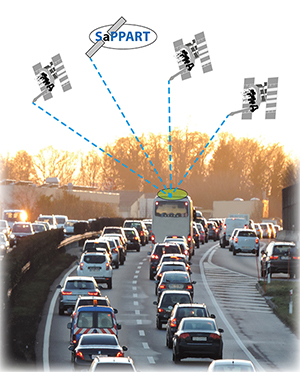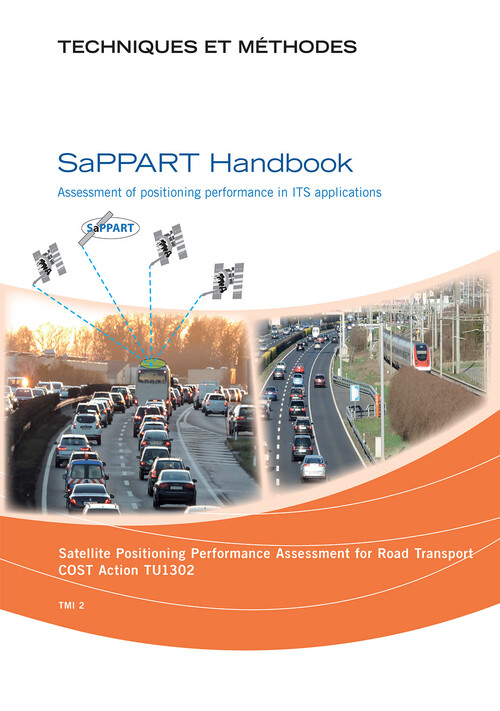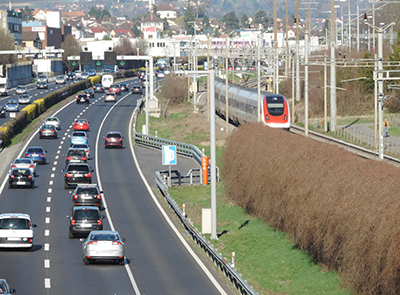SaPPART handbook
COST Action TU1302
The principles for performance assessment of GNSS-based positioning terminals in ITS applications.

The book in a few words
Effective transportation of people and goods requires an efficient positioning service. This service currently relies mainly on Global Navigation Satellite System (GNSS).
Due to the physical principle of satellite based position determination, the level of performance delivered by any terminal using GNSS highly depends on the conditions it is used in. These influencing conditions are primarily due to the physical features in the built and natural environments around the antenna, which have a strong impact on the propagation of radio-waves. Furthermore, the problem of intentional and unintentional signal interference is a major concern.
Depending on the type of application and positioning requirements, the current GNSS deficiencies can be overcome by hybridization with other positioning sensors and digital spatial data.
In the case of critical applications, the actual performance of the positioning terminal should be determined in terms of availability, accuracy and integrity.
Intelligent transport systems (ITS) stakeholders expressed the need of standardized performance metrics for positioning terminals and the associated performance assessment procedures.These issues have been addressed by the SaPPART COST action, a European network of experts in GNSS, ITS and mobility. Three deliverables have been produced on these topics.
- The white paper introduces the fundamentals of positioning systems, with the focus on GNSS, explaining their role in transportation and stressing the importance of a reliable assessment of their performance.
- The handbook is dedicated to performance issues and the principles for performance assessment of GNSS-based positioning terminals are presented.
- The guidelines provides guidelines for test procedures for the performance assessment of GNSS-based positioning terminals, either by field tests, simulations or their combination
To know more about the book
- François Peyret
- Pierre-Yves Gilliéron
- David Bétaille, Institut français des sciences et technologie des transports, de l’aménagement et des réseaux (Ifsttar), France
- Jesper Engdahl, Rapp Trans SA, Switzerland
- Vasillis Gikas, National Technical University of Athens, Greece
- Pierre-Yves Gilliéron, École polytechnique fédérale de Lausanne (EPFL), Switzerland
- Shaojun Feng, Imperial College, United Kingdom
- Ola Martin Lykkja, Q-Free, Norway
- Mihai Niculescu, Intelligent Transport Systems Romania, Romania
- Miguel Ortiz, Institut français des sciences et technologie des transports, de l’aménagement et des réseaux (Ifsttar), France
- Washington Ochieng, Imperial College, United Kingdom
- Harris Perakis, National Technical University of Athens, Greece
- François Peyret, Institut français des sciences et technologie des transports, de l’aménagement et des réseaux (Ifsttar), France
- Laura Ruotsalainen, Finnish Geospatial Research Institute, National Land Survey (FGI NLS), Finland Marko Ševrović, University of Zagreb, Croatia
- Ioanna Spyropoulou, National Technical University of Athens, Greece
- Rafael Toledo Moreo, Universidad Politécnica de Cartagena, Spain
- Silvia Andreea Voicu, Intelligent Transport Systems Romania, Romania
This handbook is the second deliverable of SaPPART COST Action, dedicated to performance issues, when positioning performance is essential to the fulfilment of the requirements of the whole ITS system. It starts by illustrating the non-straightforward nature of the role of positioning information in some emblematic applications and introduces a simulation method sensitivity analysis, as a tool to make the right choice of positioning terminal for a given application. Then, the Handbook discusses the error sources at the terminal level and introduces a model of the horizontal position error in an urban environment. In the final part, this error model and the sensitivity analysis are applied to two examples of ITS systems, namely Road User Charging and eCall, in order to illustrate how sensitive these systems are to the positioning performance.
- Table of contents
- Executive summary
- Introduction
- Chapter 1. ITS applications and required E2E performance
- Chapter 2. Positioning terminals and positioning performance
- Chapter 3. Sensitivity analysis: matching positioning performance to the required E2E performance
- List of acronyms
- List of figures
- List of tables
- Appendix A: Example of a PVT error model
COST Action TU1302. SaPPART Handbook: Assessment of positioning performance in ITS applications. Ifsttar, 2017. techniques et méthodes, TMI 2. 77p. ISBN 978-2-85782-728-3.
Identity card of the book
| Title: | SaPPART Handbook: Assessment of positioning performance in ITS applications |
| Author: | COST Action TU1302 |
| Publisher: | IFSTTAR |
| Collection: | The IFSTTAR's collections |
| Reference: | TMI2 |
| ISBN: | 978-2-85782-728-3 |
| Edition: | Pdf file, free download |
| License: | CC BY-NC-ND 4.0 |
| Publication date: | Published in june 2017 |
| Number of pages: | 77 pages |
| Language: | English |
| Key words: | positioning, GNSS, intelligent transport systems, performance, error model |
| Contact: | librairie(at)univ-eiffel.fr |




![[Translate to English:] Licence creative commons BY-SA 4.0 [Translate to English:] Licence creative commons BY-SA 4.0](https://reflexscience.univ-gustave-eiffel.fr/fileadmin/ReflexScience/Accueil/Logos/CCbySA.png)